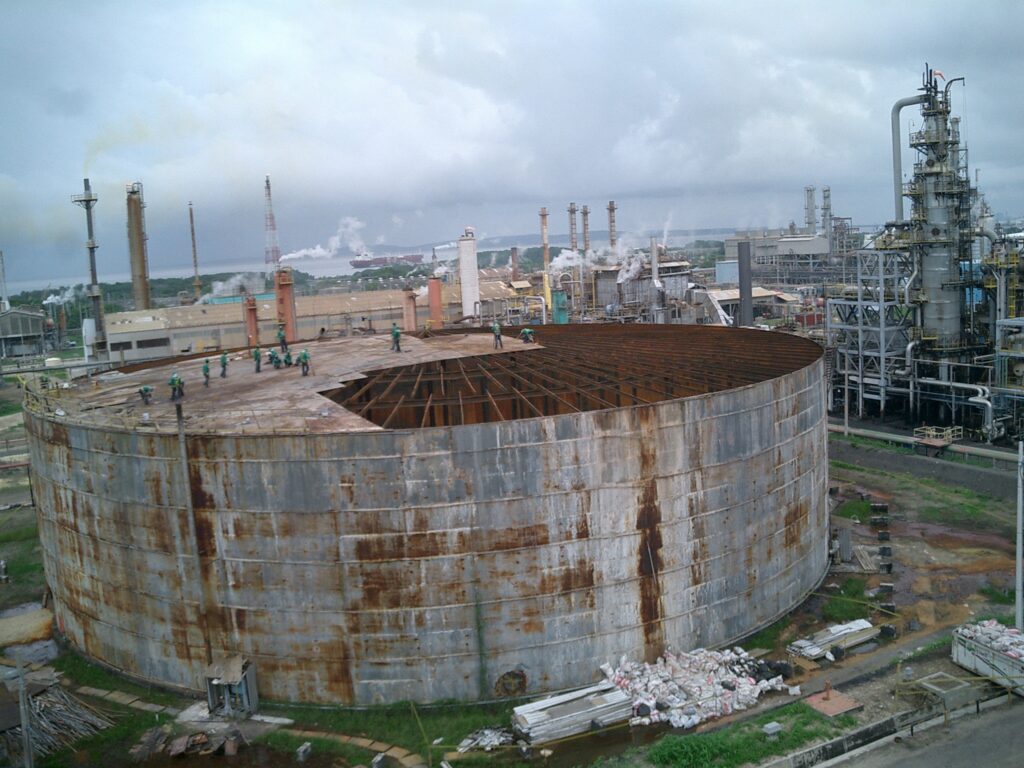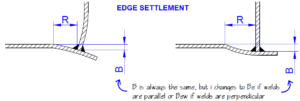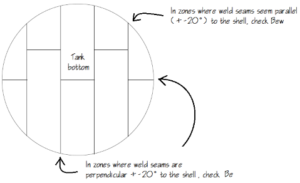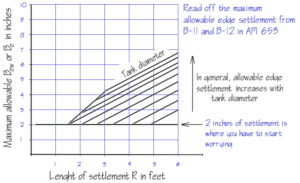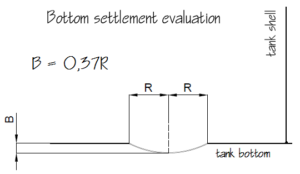By Carlos Molina.
I am writing this post because of this video that a good friend sent to me about vacuum box testing, that I want to show you. Besides, I will give you instructions for the construction of your own flat vacuum box, but first a little background.
MY FIRST CONTACT WITH STORAGE TANKS
By Carlos Molina
Last time we saw the basics of shell calculations for reconstructed tanks. Today we will make some practice exercises on determining thicknesses for reconstructed tanks
The book of knowledge says this about reconstructed tanks:
The inspector should be able to determine the minimum thickness of the shell of a reconstructed tank. The inspector should be able to:
c) Calculate “td”, design shell thickness (API-650, 5.6.3.2, for tanks of 200 foot diameter and smaller)
d) Calculate “tt”, hydrostatic test shell thickness (API-650, 5.6.3.2)
We have seen an advance to this issue in the article we had on calculating joint efficiencies, but we will have a further look to the formulas that appear there. (more…)
By Carlos Molina
Hi. This is a short post, written to teach you how to calculate the number of points for settlement measurement around a tank. If you want to become a certified API 653 inspector, this is what the body of knowledge for the 2015 API 653 certification exam asks from you
The inspector should be able to calculate the number of survey points for determining tank settlement.
At least one question on this matter will show up in the exam. And it is such an easy thing…. (more…)
By Carlos Molina
In terms of risk, catastrophic storage tank failure stands as one of the most costly events that can ever happen. It happens with no warning. It can have huge consequences of everything related to your plant: living beings, property, compliance, stakeholders, processes and finances. It is not something you would want for your facility.
Catastrophic tank failure is usually a consequence of brittle fracture, which is not always understood and is understimated when making tank repairs and inspections. Given that in some locations aboveground tanks have been in service for more than a few decades, and that is not uncommon to build a tank from parts used in other tanks, catastrophic tank failure is a real concern. (more…)
By Carlos Molina
Tank settlement is one of the topics of the Body Of Knowledge for the API 653 exam. It is a very important subject for us tank inspectors, althought is also one of the most vague topics for a new inspector. In fact, the word “settlement” is mentioned more than 250 times in the API 653 standard. As an inspector, you should be able to determine the type and extent of tank settlement, and decide if it can affect tank integrity. In the api 653 exam, maybe 2 questions will show up about this subject. And as complex as it may look in the api 653 standard, the limitations imposed by the BOK make it a really easy topic.
SETTLEMENT IN NEW CONSTRUCTION
In new tanks, the API 650 standard doesn´t necessarily asks for a settlement measurement to be done during hydrostatic tests. If there is no settlement expected (for example, a tank over a giant rock), it might not need settlement measurements, but that´s a decision that is entirely up to the owner. In normal conditions, there will always be settlement. Anyway, you should design and construct foundations to limit any settlement at all, as impossible it is to eliminate it.
For the sake of information, you should know how setttlement measurements are made. During hydrostatic testing for new and old tanks, at least 6 sets of measurements shall be made.
1. When the tank is empty before hydrostatic testing
2. When the tank is 1/4 full
3. When the tank is 1/2 full
4. When the tank is 3/4 full
4. 24 hours after it is filled
4. With the tank empty again.
Shell elevation measurements shall be made at equally-spaced intervals around the tank circumference not exceeding 10 m (32 ft)
[adToAppearHere]
SETTLEMENT OF IN-SERVICE TANKS
During operations, shell settlement measurements should be taken at a planned frequency, based on an assessment of soil settlement predictions. Bottom settlement monitoring is to be made during internal inspections, respecting the intervals given for inspections in API 653 4.4.6. Identify and evaluate any tank bottom settlement is one of the 3 key objectves of internal inspections, because it plays such an important role on many tank failures and floating-roof problems.
Settlement can be caused by the following:
- Lack of support under the base circumference affecting the cylindrical shell and the tank bottom. Parts or the concrete ring may be lost.
- Non homogeneous geometry or compressibility of the soil deposit (voids or crevices below the bottom plate)
- Non uniform distribution of the load applied to the foundation. Differential pressure during emptying and filling cycles
- Uniform stress acting over a limited area of the soil stratum
- Wrongly constructed foundations (deficient reinforcement of the concrete, bad quality cement, etc)
- Liquefaction phenomenon around the foundation generated by earthquakes. Consider the following excerpt:
The Niigata earthquake was also the first seismic disaster in Japan where the liquefaction of the ground attracted notice. Among the disaster incidents caused by the earthquake, five crude oil storage tanks in a refinery caught fire and continued burning for two weeks, spreading into the surrounding area and burning down a total of 286 adjacent houses. One of them was a 30,000kL floating roof type tank, 51,500mm in diameter, and 14,555mm in height, which was fully stocked with oil. The cause of the fire was ignition by sparks generated by the collision of the floating roof with the side wall, which in turn was caused by the movement of the crude oil by the sloshing phenomenon. Source.
WHAT YOU SHOULD STUDY FOR YOUR EXAM
Various forms of settlements could take place in tanks. The BOK considers 3 types of settlement and their evaluation.
1. Edge settlement
Edge settlement occurs when the tank shell settles sharply around the periphery, resulting in deformation of the bottom plate near the shell-to-bottom corner junction, or the depth of the depressed area of the bottom plate. You can see a diagram for edge settlement below.
Edge settlement affects bottom parallel and perpendicular welds in different manners. It affects weld seams that are “parallel” to the shell in a more critical manner that the ones that run “perpendicular”.
How to evaluate edge settlement?
STEP 1. Annex B of API 653 separates Edge Settlement evaluations in two separate scenarios:
1. If edge settlement is in an area with a welded seam than runs parallel +-20° to the shell, B turns into Bew
2. If edge settlement is in an area with a welded seam than runs perpendicular +-20° to the shell, B turns into Be
STEP 2. With the value of R, B and the tank diameter, you can check the maximum allowable vertical settlement in figures B-11 of API 653 for Bew or B-12 for Be. A sample of that diagram you can see next.
See API 653 B-11 and B-12 for the whole details.
Welds in tanks with settlement greater than or equal 75 % of Bew or Be, and larger than 2 in., are to be inspected with magnetic particle of liquid penetrant method. Additionally, weld seams should be inspected vissually and if they show strains bigger than 2%, they should be repaired. Any plate exceeding acceptable plastic strains (typically 2 % to 3 %) should be replaced.
[adToAppearHere]
2. Bottom settlement near the tank shell
This kind of settlement can be present in the bottom or in the annular ring zone, if there is one. It occurs when the bottom deforms showing a depression or a convexity in relation with a flat plane bottom. That deformation is caused by stresses in the bottom plate that have to be evaluated.
How to evaluate bulges in tank bottoms?
STEP 1. As per API 653 B3.3, measure the bulge or depression in its entire lenght. The half of that measure is radius R of the bulge.
STEP 2. The maximum dimension for bulges or depressions is given by the following equation:
Where
B is the maximum height of bulge or depth of local depression, in inches;
R is the radius of an inscribed circle in the bulged area or local depression, in feet.
3. Localized bottom settlement remote from the tank shell.
Localized bottom settlement remote from tank shell are depressions (or bulges) that occur in a random manner, remote from the shell. The same equation (B3.3) used for bottom settlement near the tank shell can be used for the evaluation of this kind of settlement, granted the bottom has single-pass welded joints.
RECOMMENDATIONS TO IMPROVE TANK RELIABILITY IN CASE OF SETTLEMENT
- Leave plenty of free space under any nozzle, to prevent any contact with the floor if there is settlement.
- Settlement occurs to every tank, and it can be different in practice from the measured settlement during and after hydrostatic testing.
- If there is uniform settled expected (If foundations werent well built), you can use flexible joints or maritime hoses that can absorb those misalignments.
- Edge settlement often can be predicted in advance, with sufficient accuracy from soil tests. Anyway, piping (especially buried piping) should be designed with adequate consideration to prevent problems caused by such settlement
CONCLUSION
See that it is pretty easy? I think this is a good explanation of what you will have to learn in order to answer correctly questions regarding tank settlement in the API 653 examination. If you liked this article that will help you in your inspections, then subscribe to my mail list, and you will receive a weekly article about equipment integrity and how to pass your exams.
Cheers and good luck
By Carlos Molina
Hi friends. Today´s article is really short, but is to let you know of the new version of the API 653 exam Simulator. This 2.0 Version has 100 questions total, an improvement of 52 from the previous version. The new simulator has some bug fixes from the former one, given that it did convert percentages to decimal points, an issue we discovered late.
This version still has to improve, and I promise that I will make my best to update it within a week to the subscribers of my blog. I have to improve the result screen and allow the user to go back to solve the test. Remember that I have a dayjob and little time, jeje.
What is the objective of this simulator? To get you accustomed to the test environment, mimicking the conditions of the actual exam. As far as I know, this simulator is one of its kind.
I took special consideration to the fact that some 70% of questions in the actual exam are from the API 653 standard, so the most of the questions in this simulator were taken from API 653. By the other side, there are new questions that aren´t in my questions series.
To receive your copy, write your mail to me and I well send it to you in the span of 1-2 business days. If you write your mail address in the form below, you will not receive any more mails regarding any other subject. I won´t collect any personal data.
Be aware that this form will work like a subscribing list, so you will have to confirm by entering to your mail account and answering an automatically generated mail.
If you would like to receive weekly updates of the articles I write here in APIEXAM, you can type your mail address next. I promise to never sell or giveaway your email address to anyone – and you are allowed to unsubscribe at anytime
Thanks and good study.
